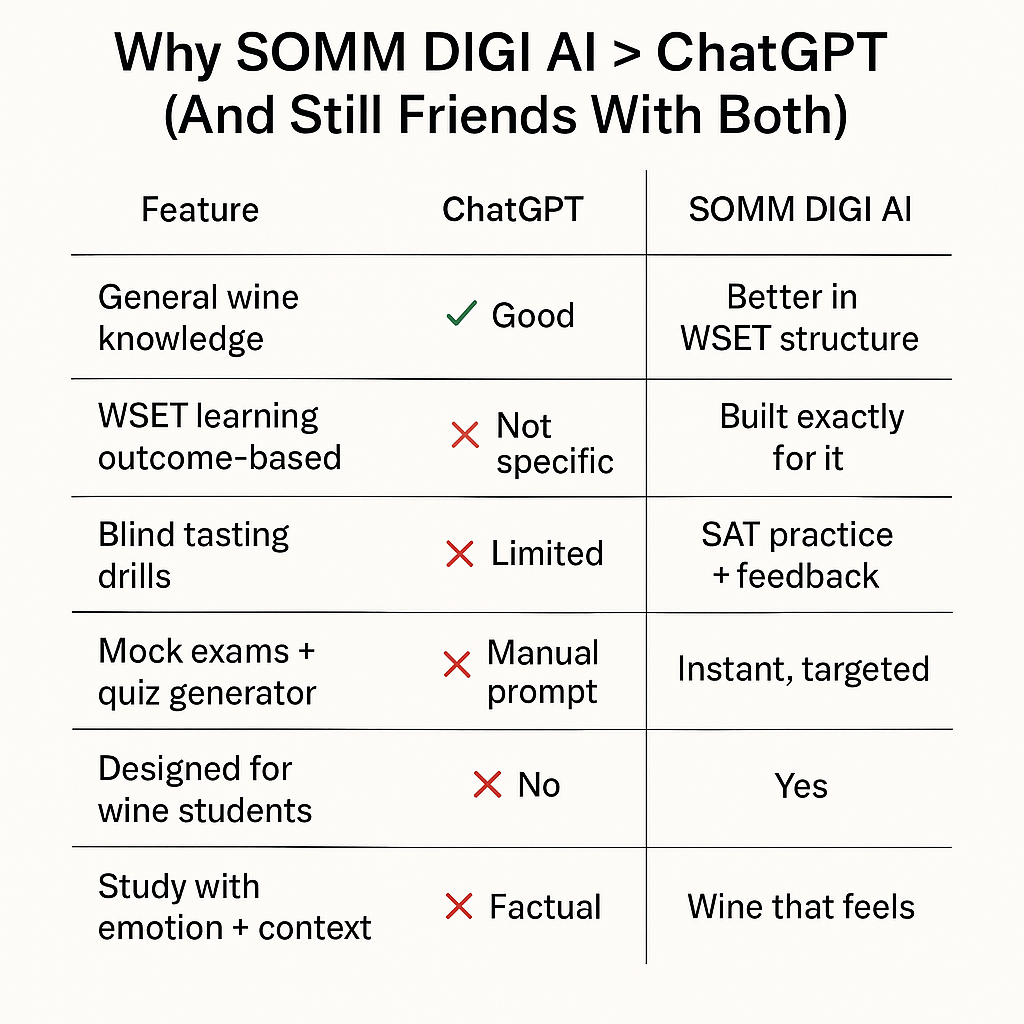🎓 Just Registered for WSET Level 3?
Here’s Where to Focus (and What the Exam Really Looks Like)
So, you signed up for WSET Level 3. That’s not just a class. It’s a shift.
It means you’re ready to not just know wine—but explain it. To move from memorizing facts to connecting dots. From naming a grape to telling its story. This is where the student becomes the professional. And that shift? It’s hard. But not impossible.
You don’t need to do this alone. Not anymore.
Welcome to your quiet weapon: AI study tools built for wine minds.
Yes, ChatGPT is out there. Yes, you can ask it questions. But SOMM DIGI AI speaks fluent WSET. It thinks in Learning Outcomes. It knows what the markers want. It gets the panic before mock exams. It’s not just a chatbot. It’s a sommelier in your pocket who never sleeps.
📚 The Syllabus: Here’s What WSET Level 3 Really Tests
WSET Level 3 is built around six Learning Outcomes (LOs) that define what you need to know, how you’ll be tested, and where the pressure lives. This isn’t just a wine course. It’s structured thinking. And every part leads somewhere.
Unit 1: Theory (LO1 to LO5)
LO1 – Natural & Human Factors:
How do natural elements (like sunlight, rain, and soil) and human decisions (like pruning, picking, and fermenting) shape the wine in your glass? This LO gives you the “why” behind every style. It's not always tested alone, but it is always inside the question.
LO1 Focus Prompts to Try (ChatGPT or SOMM DIGI AI):
"What happens to acid in a grape as temperatures rise?"
"How does canopy management affect ripeness and tannin?"
"Explain how altitude changes wine style."
"What does oak do to red wine structure?"
"Compare hand harvest vs. machine harvest."
"How does soil type influence water stress and concentration?"
"Show me examples of human factors that increase cost but improve quality."
LO2 – Principal Still Wine Regions:
This is where the exam lives. You’re expected to know not just what grows where, but why it tastes the way it does. Think of LO2 as the application of LO1 — all those climate and vineyard decisions, playing out in real regions and real wines.
LO2 Focus Prompts to Try:
"Compare Chablis and Napa Chardonnay styles and causes."
"What makes Barolo and Brunello taste so different?"
"Summarize the main wine styles of Rioja."
"How does climate affect Sauvignon Blanc in Sancerre vs Marlborough?"
"List key grape varieties of South Africa and their preferred regions."
LO3 – Sparkling Wines:
You need to know the different ways bubbles are made — and how those methods affect flavor, texture, and style. This LO covers the key global sparkling wines and how their origin + method = magic in the glass.
LO3 Focus Prompts to Try:
"Explain traditional method vs tank method."
"Why does lees aging matter in Champagne?"
"Compare Prosecco and Cava."
"List the key grapes and regions for sparkling wine."
LO4 – Fortified Wines:
From the oxidized elegance of Sherry to the sweet depth of Port — this LO covers how fortification alters the path of wine. Know the production steps, categories, aging styles, and what makes these wines age forever.
LO4 Focus Prompts to Try:
"Explain the difference between Fino and Oloroso."
"Describe the Port aging categories."
"What makes Madeira so stable?"
"Compare Tawny vs Ruby Port production."
LO5 – Service, Storage, and Advice:
It’s not enough to know wine — you have to serve it well. This LO tests practical wine life: serving temperatures, common faults, food pairings, health topics. Often overlooked, but it’s free marks if you prep right.
LO5 Focus Prompts to Try:
"How do you identify cork taint?"
"Give me 3 wine + food pairing tips."
"What storage advice would you give for fine wine?"
"Describe common wine faults and causes."
Unit 2: Tasting (LO1)
LO1 – SAT & Assessment:
This is your blind tasting challenge. Two wines, one red and one white. You’ll describe using the WSET SAT (structure, aroma, palate), then assess quality and readiness. Clear thinking, tight structure, calm execution.
Tasting Focus Prompts to Try:
"Give me a red wine SAT practice."
"How to judge quality in a white wine?"
"Is this wine ready to drink? Example answers."
"What descriptors would you use for aged Rioja?"
"Practice tasting feedback for a Cabernet Sauvignon."
What the Exam Actually Looks Like
Unit 1 — Theory
Part 1: 50 multiple-choice questions
55% to pass
4 options per question. Only 1 is right.
Mostly LO2. Be ready.
Part 2: 4 short-written questions (25 marks each)
55% to pass
All applied. Think: explain, recommend, compare.
LO1 weaves through everything. LO2 leads. LO3/4/5 support.
How to Pass This Section:
Break every region down into climate, grapes, and style.
Always link back to how that affects quality, style, and price.
Practice short-form writing. Use bullet points. Stay clear.
Don’t just memorize — explain cause and effect.
Unit 2 — Tasting
2 still wines: 1 red, 1 white
Use SAT to describe
Judge:
Quality: Faulty, Acceptable, Good, Very Good, Outstanding
Readiness: Too young, drink now, age-worthy, too old
55% to pass
How to Pass This Section:
Drill the SAT until it’s second nature. Structure first, poetry later.
Learn to justify your judgment: why is it “Very Good”?
Be consistent. Balance your structure, length, and logic.
Practice timing. 30 minutes goes fast.
🎯 Final Grades Breakdown
Pass: 55–64%
Merit: 65–79%
Distinction: 80%+
Must pass both units separately.
You don’t have to know everything. You just have to know what matters.
Whether you're asking ChatGPT or diving into SOMM DIGI AI, the real win is showing up. Practicing. Staying curious. And learning how to think like a wine pro — not just sound like one.
We built SOMM DIGI AI to help you pass faster, smarter, and with less stress. But even if you start with ChatGPT — that’s okay too.
Try those prompts. Feel the structure. Notice the difference.
SOMM DIGI AI simply takes it one layer deeper.
You’ve got this. Let’s pour into it.
Alper,


